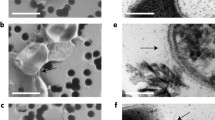Abstract
With Candida utilis cells that had been removed directly from a 61 chemostat culture, in steady state, well-coupled mitochondria generally could be isolated. This required a modified snail-gut enzyme procedure that allowed the total processing time to be decreased to 3 h, or less. Examination of these mitochondria in an oxygraph showed the presence of 3 sites of energy conservation when the cells were grown at various dilution rates between 0.1 and 0.45 h-1 in environments that were, successively, glucose-, ammonia-, magnesium-, phosphate- and sulphate-limited. Potassium-limited cells also apparently possessed 3 sites of oxidative phosphorylation when growing at dilution rates greater than 0.2 h-1, but only 2 sites when growing at lower dilution rates. Analysis of cytochrome spectra obtained with these intact mitochondria revealed large quantitative (but not qualitative) differences, depending on the environmental conditions under which the yeast had been cultured. In particular, comparison of the ratio of cytochrome b to cytochrome a showed a pattern of change with dilution rate in mitochondria from potassium-limited cells that was distinctly different from those evident in mitochondria from cells that had been limited in their growth by the availability of other nutrients.
Similar content being viewed by others
References
Adam, H.: Adenosin-5′-diphosphat und Adenosin-5′-monophosphat. In: Methoden der Enzymatischen Analyse (H. U. Bergmeyer, Hrsg.), S. 573–577. Weinheim: Verlag Chemie 1962
Aiking, H., Tempest, D. W.: Growth and physiology of Candida utilis NCYC 321 in potassium-limited chemostat culture. Arch. Microbiol. 108, 117–124 (1976)
Beck, J. C., Mattoon, J. R., Hawthorne, P. C., Sherman, F.: Genetic modification of energy-conserving systems in yeast mitochondria. Proc. nat. Acad. Sci. (Wash.) 60, 186–193 (1968)
Berden, J. A., Slater, E. C.: The reaction of antimycin with a cytochrome b preparation active in reconstitution of the respiratory chain. Biochim. biophys. Acta (Amst.) 216, 237–249 (1970)
Blond, D. M., Whittam, R.: Effects of sodium and potassium ions on oxidative phosphorylation in relation to respiratory control by a cell-membrane adenosinetriphosphatase. Biochem. J. 97, 523–531 (1965)
Chance, B., Williams, G. R.: The respiratory chain and oxidative phosphorylation. Advanc. Enzymol. 17, 65–134 (1956)
van Gelder, B. F.: On cytochrome c oxidase. I. The extinction coefficients of cytochrome a and cytochrome aa 3. Biochim. biophys. Acta (Amst.) 118, 36–46 (1966)
Gómez-Puyou, A., Sandoval, F., Tuena de Gómez-Puyou, M., Peña, A., Chávez, E.: Coupling of oxidative phosphorylation by monovalent cations. Biochemistry 11, 97–102 (1972)
Haddock, B. A., Garland, P. B.: Effect of sulphate-limited growth on mitochondrial electron transfer and energy conservation between reduced nicotinamide-adenine dinucleotide and the cytochromes in Torulopsis utilis. Biochem. J. 124, 155–170 (1971)
Herbert, D., Phipps, P. J., Tempest, D. W.: The chemostat: design and instrumentation. Lab. Pract. 14, 1150–1161 (1965)
Kováč, L., Bednárová, H., Greksak, M.: Oxidative phosphorylation in yeast. I. Isolation and properties of phosphorylating mitochondria from stationary phase cells. Biochim. biophys. Acta (Amst.) 153, 32–42 (1968)
Light, P. A.: Influence of environment on mitochondrial function in yeast. J. appl. Chem. Biotechnol. 22, 509–526 (1972)
Light, P. A., Garland, P. B.: A comparison of mitochondria from Torulopsis utilis grown in continuous culture with glycerol, iron, ammonium, magnesium or phosphate as the growth-limiting nutrient. Biochem. J. 124, 123–134 (1971)
Lowry, O. H., Rosebrough, N. J., Farr, A. L., Randall, R. J.: Protein measurement with the Folin phenol reagent. J. biol. Chem. 193, 265–275 (1951)
Ohnishi, T., Kawaguchi, K., Hagihara, B.: Preparation and some properties of yeast mitochondria. J. biol. Chem. 241, 1797–1806 (1966a)
Ohnishi, T., Sottocasa, G., Ernster, L.: Current approaches to the mechanism of energy-coupling in the respiratory chain: studies with yeast mitochondria. Bull. Soc. Chim. biol. (Paris) 48, 1189–1203 (1966b)
Tempest, D. W.: The place of continuous culture in microbial research. In: Advances in microbial physiology, Vol. 4 (A. H. Rose, J. F. Wilkinson, eds.), pp. 223–250. London-New York: Academic Press 1970
Author information
Authors and Affiliations
Rights and permissions
About this article
Cite this article
Aiking, H., Sterkenburg, A. & Tempest, D.W. Influence of specific growth limitation and dilution rate on the phosphorylation efficiency and cytochrome content of mitochondria of Candida utilis NCYC 321. Arch. Microbiol. 113, 65–72 (1977). https://doi.org/10.1007/BF00428582
Received:
Issue Date:
DOI: https://doi.org/10.1007/BF00428582




